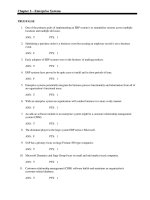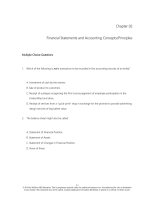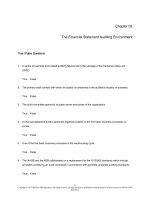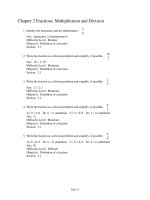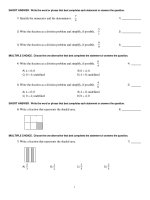Zoology 10th edition miller test bank
Bạn đang xem bản rút gọn của tài liệu. Xem và tải ngay bản đầy đủ của tài liệu tại đây (52.68 KB, 17 trang )
Chapter 02 - Cells, Tissues, Organs, and Organ Systems of Animals
Chapter 02
Cells, Tissues, Organs, and Organ Systems of Animals
Multiple Choice Questions
1. The simplest organization of matter that exhibits the properties of life is the
A. cell.
B. tissue.
C. protein.
D. nucleic acid.
E. organism.
Blooms Level: 1. Remember
Learning Outcome: Describe, from the simplest to the most complex, the five levels of organization in a higher animal.
Section: 02.01
Topic: What Are Cells?
2. Which of the following is part of plant cells but not animal cells?
A. mitochondria
B. endoplasmic reticulum
C. plasma membrane
D. cell wall
E. nucleus
Blooms Level: 1. Remember
Learning Outcome: Relate the structure of the major cellular organelles to their function.
Section: 02.05
Topic: Cytoplasm, Organelles, and Cellular Components
2-1
Copyright © 2016 McGraw-Hill Education. All rights reserved. No reproduction or distribution without the prior written consent of
McGraw-Hill Education.
Chapter 02 - Cells, Tissues, Organs, and Organ Systems of Animals
3. Which of the following is found in animal cells, but is not usually found in plant cells?
A. chromosomes
B. Golgi apparatus
C. mitochondria
D. plasma membrane
E. centrioles
Blooms Level: 1. Remember
Learning Outcome: Relate the structure of the major cellular organelles to their function.
Section: 02.05
Topic: Cytoplasm, Organelles, and Cellular Components
4. A cell in which the DNA is not bound by a membrane is said to be
A. prokaryotic.
B. organoid.
C. eukaryotic.
D. symbiotic.
E. endosymbiotic.
Blooms Level: 1. Remember
Learning Outcome: Differentiate between a prokaryotic and eukaryotic cell.
Section: 02.01
Topic: What Are Cells?
5. A cell with a membrane-bound nucleus, containing DNA in organized structures called
chromosomes is said to be
A. symbiotic.
B. eukaryotic.
C. organoid.
D. prokaryotic.
E. endosymbiotic.
Blooms Level: 1. Remember
Learning Outcome: Differentiate between a prokaryotic and eukaryotic cell.
Section: 02.01
Topic: What Are Cells?
2-2
Copyright © 2016 McGraw-Hill Education. All rights reserved. No reproduction or distribution without the prior written consent of
McGraw-Hill Education.
Chapter 02 - Cells, Tissues, Organs, and Organ Systems of Animals
6. A cell that has membrane-bound units called organelles and a cytoskeleton is said to be
A. prokaryotic.
B. organoid.
C. eukaryotic.
D. symbiotic.
E. endosymbiotic.
Blooms Level: 1. Remember
Learning Outcome: Differentiate between a prokaryotic and eukaryotic cell.
Section: 02.01
Topic: What Are Cells?
7. An organelle that is used for storage and internal transport, serves as a site for attachment
of ribosomes, and makes steroids, is the
A. cytoskeleton.
B. mitochondrion.
C. lysosome.
D. endoplasmic reticulum.
E. centriole.
Blooms Level: 2. Understand
Learning Outcome: Relate the structure of the major cellular organelles to their function.
Section: 02.05
Topic: Cytoplasm, Organelles, and Cellular Components
8. The organelle that packages and routes the synthesized products of a eukaryotic cell is the
A. flagellum.
B. ribosome.
C. peroxisome.
D. nucleolus.
E. Golgi apparatus.
Blooms Level: 2. Understand
Learning Outcome: Relate the structure of the major cellular organelles to their function.
Section: 02.05
Topic: Cytoplasm, Organelles, and Cellular Components
2-3
Copyright © 2016 McGraw-Hill Education. All rights reserved. No reproduction or distribution without the prior written consent of
McGraw-Hill Education.
Chapter 02 - Cells, Tissues, Organs, and Organ Systems of Animals
9. These structures are an example of a microbody.
A. ribosome
B. vault
C. peroxisome
D. golgi apparatus
E. rough endoplasmic reticulum
Blooms Level: 1. Remember
Learning Outcome: Relate the structure of the major cellular organelles to their function.
Section: 02.05
Topic: Cytoplasm, Organelles, and Cellular Components
10. These structures have recently been shown to act as signal-receiving "antennae" for cells
that help them monitor the extracellular environment.
A. vacuoles
B. mitochondria
C. smooth endoplasmic reticulum
D. cilia
E. rough endoplasmic reticulum
Blooms Level: 2. Understand
Learning Outcome: Relate the structure of the major cellular organelles to their function.
Section: 02.05
Topic: Cytoplasm, Organelles, and Cellular Components
11. This organelle functions in cell division and organization of the cytoskeleton.
A. mitochondrion
B. centriole
C. endoplasmic reticulum
D. chloroplast
E. lysosome
Blooms Level: 2. Understand
Learning Outcome: Relate the structure of the major cellular organelles to their function.
Section: 02.05
Topic: Cytoplasm, Organelles, and Cellular Components
2-4
Copyright © 2016 McGraw-Hill Education. All rights reserved. No reproduction or distribution without the prior written consent of
McGraw-Hill Education.
Chapter 02 - Cells, Tissues, Organs, and Organ Systems of Animals
12. The semifluid phase of the cytoplasm that contains organelles, vesicles, and inclusions,
and serves as a medium for metabolic reactions is the
A. nucleoplasm.
B. cytoskeleton.
C. cytosol.
D. peroxisome.
E. plasma membrane.
Blooms Level: 2. Understand
Learning Outcome: Describe the three parts of a eukaryotic cell.
Section: 02.05
Topic: Cytoplasm, Organelles, and Cellular Components
13. The __________ of the mitochondria function in increasing the inner membranous surface
area.
A. centrioles
B. matrix
C. strobili
D. cristae
E. thylakoids
Blooms Level: 2. Understand
Learning Outcome: Relate the structure of the major cellular organelles to their function.
Section: 02.05
Topic: Cytoplasm, Organelles, and Cellular Components
14. The surface to volume ratio of a cell limits
A. the type of organelles present.
B. the organelle/microtubule volume.
C. the number of organelles present.
D. the plasma membrane/DNA volume.
E. the size a cell may reach.
Blooms Level: 2. Understand
Learning Outcome: Explain why most cells are small.
Section: 02.03
Topic: Why Are Most Cells Small?
2-5
Copyright © 2016 McGraw-Hill Education. All rights reserved. No reproduction or distribution without the prior written consent of
McGraw-Hill Education.
Chapter 02 - Cells, Tissues, Organs, and Organ Systems of Animals
15. As the radius of a cell increases, the surface area ______ and the ratio of surface area to
volume _______.
A. decreases; increases
B. increases; decreases
C. decreases; remains the same
D. increases; remains the same
E. remains the same; increases
Blooms Level: 2. Understand
Learning Outcome: Explain why most cells are small.
Section: 02.03
Topic: Why Are Most Cells Small?
16. The fluid mosaic model of membrane structure was developed by
A. Singer and Nicolson.
B. Garth and Richardson.
C. Schleiden and Schwann.
D. Singer and Schleiden.
E. Johnson and Garth.
Blooms Level: 1. Remember
Learning Outcome: Relate the structure of the plasma membrane to the function of the membrane.
Section: 02.03
Topic: Cell Membranes
17. Membrane proteins attached to the inner or outer surfaces of plasma membranes are called
__________ proteins.
A. intrinsic
B. hydrophobic
C. peripheral
D. hydrophilic
E. mosaic
Blooms Level: 2. Understand
Learning Outcome: Relate the structure of the plasma membrane to the function of the membrane.
Section: 02.03
Topic: Cell Membranes
2-6
Copyright © 2016 McGraw-Hill Education. All rights reserved. No reproduction or distribution without the prior written consent of
McGraw-Hill Education.
Chapter 02 - Cells, Tissues, Organs, and Organ Systems of Animals
18. Membrane proteins that are embedded within the membrane and may function in moving
materials across the membrane are called __________ proteins.
A. hydrophobic
B. extrinsic
C. mosaic
D. intrinsic
E. hydrophilic
Blooms Level: 2. Understand
Learning Outcome: Relate the structure of the plasma membrane to the function of the membrane.
Section: 02.03
Topic: Cell Membranes
19. The "cell coat," made of surface carbohydrates and portions of proteins, is called the
A. tunic.
B. cell wall.
C. plasma membrane.
D. desmosome.
E. glycocalyx.
Blooms Level: 2. Understand
Learning Outcome: Relate the structure of the plasma membrane to the function of the membrane.
Section: 02.03
Topic: Cell Membranes
20. The ability of a membrane to regulate passage of materials into and out of a cell is called
A. selective permeability.
B. innate regulation.
C. active transport.
D. membrane uniformity.
E. homeostasis.
Blooms Level: 2. Understand
Learning Outcome: Differentiate the different processes by which material can move into and out of the cell through the plasma membrane.
Section: 02.04
Topic: Movement across Membranes
2-7
Copyright © 2016 McGraw-Hill Education. All rights reserved. No reproduction or distribution without the prior written consent of
McGraw-Hill Education.
Chapter 02 - Cells, Tissues, Organs, and Organ Systems of Animals
21. Water molecules move through selectively permeable membranes from areas of high
concentration of water to areas of lower concentration by
A. simple diffusion.
B. endocytosis.
C. osmosis.
D. facilitated diffusion.
E. hydrostatic infusion.
Blooms Level: 2. Understand
Learning Outcome: Explain the movement of water by osmosis.
Section: 02.04
Topic: Movement across Membranes
22. When molecules bind temporarily with a carrier protein in a cell's membrane and move
across the membrane from areas of higher concentration to areas of lower concentration this is
known as
A. simple diffusion.
B. endocytosis.
C. receptor-mediated osmosis.
D. active transport.
E. facilitated diffusion.
Blooms Level: 2. Understand
Learning Outcome: Differentiate the different processes by which material can move into and out of the cell through the plasma membrane.
Section: 02.04
Topic: Movement across Membranes
23. The form of transport involved when blood pressure forces water and small dissolved
molecules into kidney tubules is
A. osmosis.
B. simple diffusion.
C. complex diffusion.
D. filtration.
E. facilitated diffusion.
Blooms Level: 2. Understand
Learning Outcome: Differentiate the different processes by which material can move into and out of the cell through the plasma membrane.
Section: 02.04
Topic: Movement across Membranes
2-8
Copyright © 2016 McGraw-Hill Education. All rights reserved. No reproduction or distribution without the prior written consent of
McGraw-Hill Education.
Chapter 02 - Cells, Tissues, Organs, and Organ Systems of Animals
24. Cells placed in this type of solution will shrivel.
A. isotonic
B. water
C. hypertonic
D. hypotonic
E. metatonic
Blooms Level: 2. Understand
Learning Outcome: Explain the movement of water by osmosis.
Section: 02.04
Topic: Movement across Membranes
25. Active transport
A. can only move molecules from higher to lower concentrations.
B. uses cellular energy to move molecules from lower to higher concentrations.
C. moves molecules through protein channels by binding them to large lipid molecules.
D. can only move protein molecules.
E. can only move carbohydrate molecules.
Blooms Level: 2. Understand
Learning Outcome: Differentiate the different processes by which material can move into and out of the cell through the plasma membrane.
Section: 02.04
Topic: Movement across Membranes
26. This carrier protein transports two molecules or ions in opposite directions.
A. Uniporter
B. Symporter
C. Antiporter
D. Cotransporter
E. Proporter
Blooms Level: 2. Understand
Learning Outcome: Differentiate the different processes by which material can move into and out of the cell through the plasma membrane.
Section: 02.04
Topic: Movement across Membranes
2-9
Copyright © 2016 McGraw-Hill Education. All rights reserved. No reproduction or distribution without the prior written consent of
McGraw-Hill Education.
Chapter 02 - Cells, Tissues, Organs, and Organ Systems of Animals
27. Small hydrophilic molecules such as ____________ are sometimes able to enter a cell
through an aquaporin.
A. glycerol
B. cholesterol
C. glucose
D. beta carotene
E. vitamin D
Blooms Level: 2. Understand
Learning Outcome: Explain the movement of water by osmosis.
Section: 02.04
Topic: Movement across Membranes
28. When a plasma membrane encloses small fluid droplets and takes them into the cell, a
form of transport known as __________ occurs.
A. active diffusion
B. receptor-mediated exocytosis
C. pinocytosis
D. facilitated diffusion
E. phagocytosis
Blooms Level: 2. Understand
Learning Outcome: Differentiate the different processes by which material can move into and out of the cell through the plasma membrane.
Section: 02.04
Topic: Movement across Membranes
29. When cells such as white blood cells of a vertebrate engulf bacteria, the membrane
transport mechanism used is
A. receptor-mediated endocytosis.
B. active transport.
C. passive transport.
D. phagocytosis.
E. exocytosis.
Blooms Level: 2. Understand
Learning Outcome: Differentiate the different processes by which material can move into and out of the cell through the plasma membrane.
Section: 02.04
Topic: Movement across Membranes
2-10
Copyright © 2016 McGraw-Hill Education. All rights reserved. No reproduction or distribution without the prior written consent of
McGraw-Hill Education.
Chapter 02 - Cells, Tissues, Organs, and Organ Systems of Animals
30. Two important and well-known active transport mechanisms in nerve cells are the
__________ pumps.
A. sodium-phosphorus and calcium
B. calcium and sulfur
C. oxygen and carbon dioxide
D. protein and nucleic acid
E. calcium and sodium-potassium
Blooms Level: 2. Understand
Learning Outcome: Differentiate the different processes by which material can move into and out of the cell through the plasma membrane.
Section: 02.04
Topic: Movement across Membranes
31. The protein composing the filaments inside cilia and flagella is
A. tubulin.
B. actin.
C. myosin.
D. mucin.
E. collagen.
Blooms Level: 2. Understand
Learning Outcome: Relate the structure of the major cellular organelles to their function.
Section: 02.05
Topic: Cytoplasm, Organelles, and Cellular Components
32. Structures associated with the endoplasmic reticulum, necessary for protein synthesis are
the
A. desmosomes.
B. ribosomes.
C. peroxisomes.
D. chromosomes.
E. nucleosomes.
Blooms Level: 2. Understand
Learning Outcome: Relate the structure of the major cellular organelles to their function.
Section: 02.05
Topic: Cytoplasm, Organelles, and Cellular Components
2-11
Copyright © 2016 McGraw-Hill Education. All rights reserved. No reproduction or distribution without the prior written consent of
McGraw-Hill Education.
Chapter 02 - Cells, Tissues, Organs, and Organ Systems of Animals
33. The organelle that is especially prominent and well-developed in secretory cells (such as
glandular epithelial cells) is the
A. centriole.
B. phagolysosome.
C. Golgi apparatus.
D. mitochondrion.
E. peroxisome.
Blooms Level: 2. Understand
Learning Outcome: Relate the structure of the major cellular organelles to their function.
Section: 02.05
Topic: Cytoplasm, Organelles, and Cellular Components
34. The structures which are elongated appendages used for propelling the cell or for moving
material over the cell surface are the
A. cilia and flagella.
B. axonemes and myonemes.
C. basal bodies and centrioles.
D. microtubules and microfilaments.
E. axopodia and myopodia.
Blooms Level: 2. Understand
Learning Outcome: Relate the structure of the major cellular organelles to their function.
Section: 02.05
Topic: Cytoplasm, Organelles, and Cellular Components
35. A major function of the cell nucleus is
A. storing proteins.
B. storing genetic information.
C. packaging materials for secretion.
D. packaging ATP for cellular use.
E. serving as a site for protein synthesis.
Blooms Level: 2. Understand
Learning Outcome: Categorize the functions of the nucleus in terms of structure of the nucleus.
Section: 02.06
Topic: The nucleus: Information center
2-12
Copyright © 2016 McGraw-Hill Education. All rights reserved. No reproduction or distribution without the prior written consent of
McGraw-Hill Education.
Chapter 02 - Cells, Tissues, Organs, and Organ Systems of Animals
36. The nuclear envelope is continuous with the __________ at a number of points.
A. plasma membrane
B. Golgi apparatus
C. endoplasmic reticulum
D. mitochondria
E. cytoskeleton
Blooms Level: 2. Understand
Learning Outcome: Categorize the functions of the nucleus in terms of structure of the nucleus.
Section: 02.06
Topic: The nucleus: Information center
37. The __________ is an organelle inside the nucleus that serves as the pre-assembly point
for ribosomes.
A. nucleosome
B. nucleotide
C. nucleoplasm
D. nucleolus
E. nucleoside
Blooms Level: 2. Understand
Learning Outcome: Categorize the functions of the nucleus in terms of structure of the nucleus.
Section: 02.06
Topic: The nucleus: Information center
38. ________ are newly discovered organelles believed to aid in transport of messenger RNA
into the cytoplasm of eukaryotic cells.
A. Vaults
B. Ribosomes
C. Peroxisomes
D. Nucleoli
E. Centrioles
Blooms Level: 2. Understand
Learning Outcome: Relate the structure of the major cellular organelles to their function.
Section: 02.05
Topic: Cytoplasm, Organelles, and Cellular Components
2-13
Copyright © 2016 McGraw-Hill Education. All rights reserved. No reproduction or distribution without the prior written consent of
McGraw-Hill Education.
Chapter 02 - Cells, Tissues, Organs, and Organ Systems of Animals
39. Which of the following is not an example of an organ system?
A. digestive
B. lymphatic
C. respiratory
D. nervous
E. blood
Blooms Level: 2. Understand
Learning Outcome: Describe an organ as found in a mammal.
Section: 02.10
40. The type of tissue that covers or lines structures is
A. epithelial tissue.
B. fibrous tissue.
C. adipose tissue.
D. contractile tissue.
E. skeletal tissue.
Blooms Level: 2. Understand
Learning Outcome: Explain the structure and function of different epithelia.
Section: 02.08
Topic: Tissues
41. Spaces within bone or cartilage which house the living cells are called
A. chondrocytes.
B. lacunae.
C. osteoclasts.
D. intercalations.
E. cristae.
Blooms Level: 1. Remember
Learning Outcome: Identify the different types of connective tissue.
Section: 02.08
Topic: Tissues
2-14
Copyright © 2016 McGraw-Hill Education. All rights reserved. No reproduction or distribution without the prior written consent of
McGraw-Hill Education.
Chapter 02 - Cells, Tissues, Organs, and Organ Systems of Animals
42. Fibrous connective tissue in the form of __________ connects bones to bones.
A. ligaments
B. fascia
C. tendons
D. adipose tissue
E. hyaline cartilage
Learning Outcome: Identify the different types of connective tissue.
Section: 02.08
Topic: Tissues
43. Blood is considered to be a/an __________ tissue.
A. epithelial
B. liquid
C. hyaline
D. connective
E. adipose
Blooms Level: 2. Understand
Learning Outcome: Identify the different types of connective tissue.
Section: 02.08
Topic: Tissues
44. Heart, lungs, and liver are examples of functional units called
A. tissues.
B. organelles.
C. systems.
D. histological entities.
E. organs.
Blooms Level: 1. Remember
Learning Outcome: Describe an organ as found in a mammal.
Section: 02.08
Topic: Tissues
2-15
Copyright © 2016 McGraw-Hill Education. All rights reserved. No reproduction or distribution without the prior written consent of
McGraw-Hill Education.
Chapter 02 - Cells, Tissues, Organs, and Organ Systems of Animals
45. Two organelles called __________ lie at right angles to each other near the nucleus and
are involved with movement of the chromosomes during cell division.
A. centrioles
B. centrosomes
C. centromeres
D. concentricyclones
E. cycloses
Blooms Level: 2. Understand
Learning Outcome: Relate the structure of the major cellular organelles to their function.
Section: 02.05
Topic: Cytoplasm, Organelles, and Cellular Components
46. __________ transport molecules made in the nucleus to various parts of the cell.
A. Centrioles
B. Barrels
C. Vaults
D. Autosomes
E. Motorists
Blooms Level: 2. Understand
Learning Outcome: Relate the structure of the major cellular organelles to their function.
Section: 02.05
Topic: Cytoplasm, Organelles, and Cellular Components
47. There are three types of muscle tissue, yet they all share one common feature. Of the
following, which describes this feature?
A. The cells in muscle tissue can shorten and accomplish movement.
B. Muscle tissue is attached to the skeleton of the body.
C. Muscle tissue is striated.
D. The cells in muscle tissue all have a centrally located nucleus.
Blooms Level: 2. Understand
Learning Outcome: Identify a unique feature of muscle cells.
Section: 02.08
Topic: Tissues
2-16
Copyright © 2016 McGraw-Hill Education. All rights reserved. No reproduction or distribution without the prior written consent of
McGraw-Hill Education.
Chapter 02 - Cells, Tissues, Organs, and Organ Systems of Animals
True / False Questions
48. The basic function of neurons is to conduct a nerve impulse.
TRUE
Blooms Level: 2. Understand
Learning Outcome: Describe the basic function of neurons.
Section: 02.08
Topic: Tissues
Multiple Choice Questions
49. Which of the following are functions of exosomes?
A. Contain cell-specific payloads of proteins.
B. May alter cellular functions.
C. Secreted by most types of cells.
D. Both A and B.
E. A, B and C.
Blooms Level: 2. Understand
Learning Outcome: Relate the structure of the major cellular organelles to their function.
Section: 02.05
Topic: Cytoplasm, Organelles, and Cellular Components
2-17
Copyright © 2016 McGraw-Hill Education. All rights reserved. No reproduction or distribution without the prior written consent of
McGraw-Hill Education.
